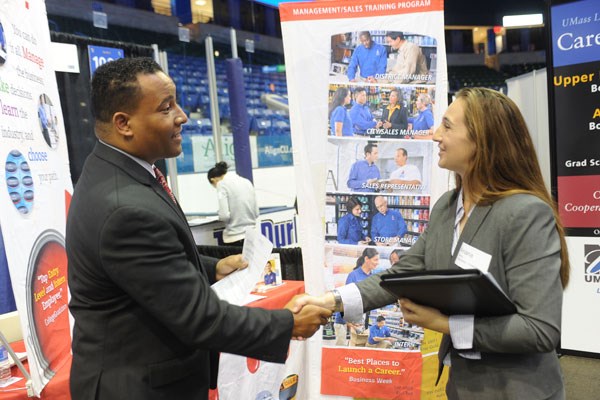New Report on Class of 2014 Shows 94% Either Working or in Grad School

By taking advantage of networking opportunities such as Career Fairs, two-thirds of the Class of 2014 have landed jobs, according to a new report from Career Services. An additional 28 percent of those surveyed were attending grad school.
05/01/2015
By Ed Brennen
According to a recently released report from the Career Services & Cooperative Education Center, 94 percent of undergraduates from UMass Lowell’s Class of 2014 were either employed or continuing their education by the end of 2014.
Compiled by Assistant Dean of Student Affairs for Career Development Greg Denon and his staff, the “Class of 2013-14 Career & Advanced Degree Outcomes” report (pdf) marks the first time Career Services has comprehensively tracked graduates’ post-commencement progress.
“We had no data on what our graduates were doing beyond graduation,” says Denon, who joined Career Services in January 2014. “We would poll them at Cap and Gown, but industry knowledge says most students get a job within three to six months after graduation. So we had no data about the success of our graduates.”
Data was gathered on 1,047 students who graduated between July 1, 2013 and June 30, 2014, or 56 percent of the 1,857 total undergrads in that time frame.
Of that sample size, 66 percent were employed by Dec. 31, 2014, while 28 percent were pursuing a graduate degree. The remaining 6 percent seeking employment was on par with the national unemployment rate, which stood at 5.5 percent as of March 2015.
Denon and his team used a variety of methods to gather data, including periodic online surveys, LinkedIn research, university enrollment records, job search activity through CareerLink and knowledge from faculty and staff.
While salary information was limited to 139 graduates, it did show that the average starting salary for the Class of 2014 was $45,585. Breaking it down by majors, chemical engineers had the highest average salary at $68,000, while the highest reported salary was $96,000 for an electrical engineer.
According to PayScale’s 2014 College Salary Report, UMass Lowell is the top-ranked public research institution in New England for salary potential, with an average mid-career salary of $95,100.
“With LinkedIn, you know employment or grad school status but not salary. I wish we had more salary data than we do, so that’s another piece to look at how to get more,” says Denon, who has already begun compiling data for next year’s report on the Class of 2015.
“We’ll be able to compare the numbers year to year, which will be very useful,” says Denon, who is also funneling the university’s information to the National Association of Colleges and Employers (NACE) for the first time “so we’ll know this year how we compare at the national level.”
“This is the first year that there’s been a national standard set by NACE,” Denon adds, “so that we’re all reporting on the same data rather than each interpreting what employment means. Is it full-time? Part-time? Freelance? Starting your own business?”
Here’s a college-by-college look at the report’s findings:
| College | Employed | Continuing Education | Average Starting Salary |
|---|---|---|---|
| Engineering | 66% | 26% | $57,747 |
| Fine Arts, Humanities & Social Sciences | 64% | 29% | $32,164 |
| Health Sciences | 52% | 42% | 42,527 |
| Manning School of Business | 82% | 14% | 43,392 |
| Sciences | 47% | 49% | $54,573 |
